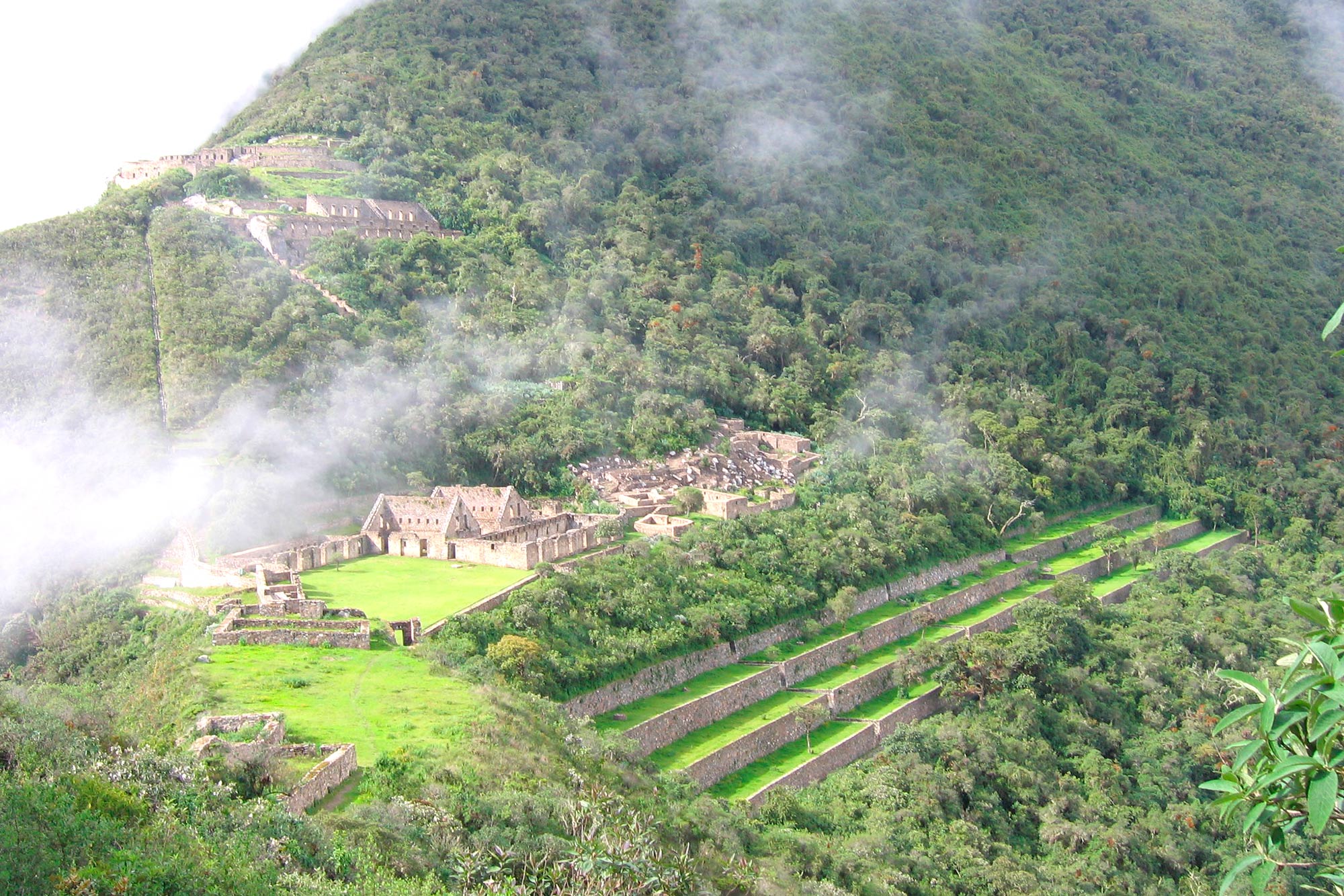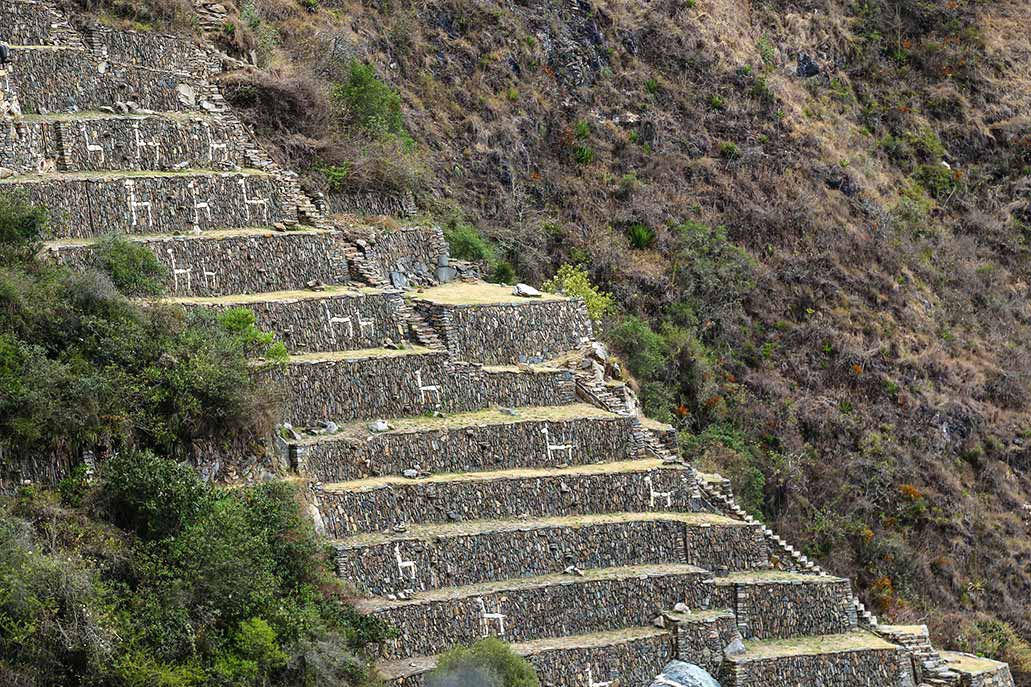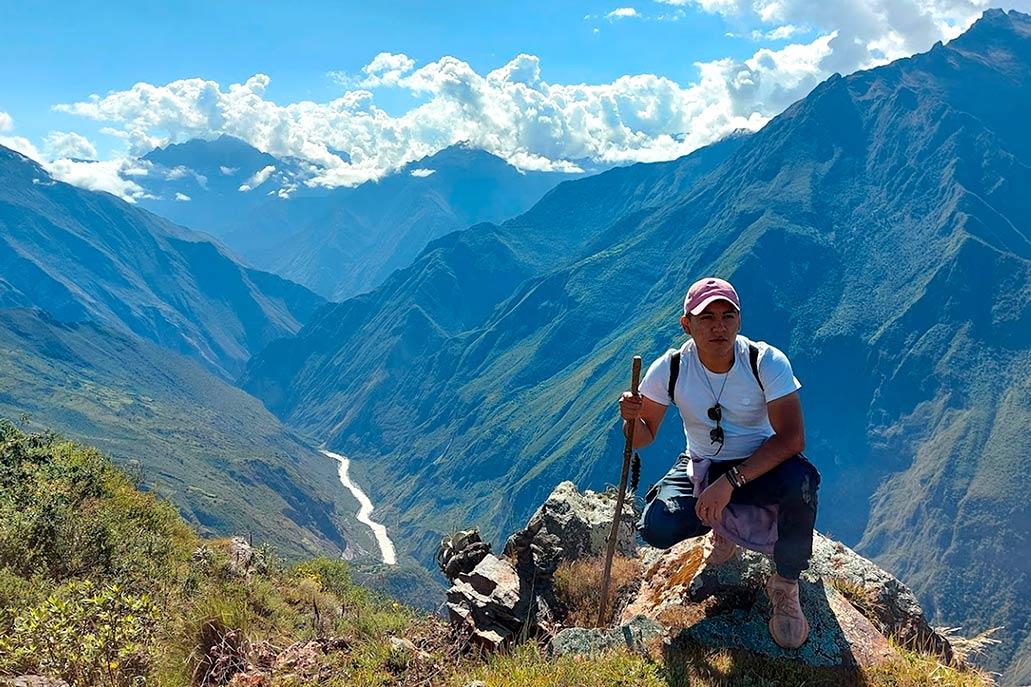Choquequirao, the last Inca site among the clouds of Cusco
Choquequirao is a unique and little-known destination. Its visit is recommended to adventure lovers. The only way to get there is by foot. In addition, it connects on an eight-day hiking route, starting from Cusco, with the wonderful Machu Picchu. Choquequirao is a sacred place, it is barely known by the most daring visitors.
Content
1. A destination only for the brave
The tour that takes us to Choquequirao has nothing to envy to the most acclaimed hiking trails in the world. Carrying out this route is something told, barely, by a few brave people. Located on the edge of the Cusco jungle, it is said that its main function was to be the connection point between the jungle and the mountains. It is also one of the hiking trails to get to Machu Picchu.
Choquequirao, is thus understood as an archaeological monument. Actually, one of the most important in Cusco and Peru. Not only because of the history that it brings with it, but also because of its exclusive location and the important remains left by this citadel.
An important factor in considering this place is that it was built from scratch. That is to say, the urban planners of the empire or the Inca himself, decided to build said enclosure, without previously having created or invaded a town before. Choquequirao shows that spectacular management of the topography of the place and the use of nature itself to modify it as a citadel. It is estimated that several cities would be built to achieve greater control within the Tawantinsuyo.
Something important about venturing on this journey is that you will follow the paths traced by the Incas themselves, we refer to the Qhapaq Ñan. This path is well signposted. The route can be taken without resorting to a tourism agency or buying a tour package. Whoever is ready to cross the mountains and reach the jungle, take your best shoes and start this wonderful journey.
2. Choquequirao and the new capitals of Tawantinsuyo
According to some studies, Choquequirao should be seen as an enclosure destined to be a possible new city. In the remains found, an important distribution of sectors can be observed. This organization, seen in Cusco and Machu Picchu, is the main characteristic to understand the hierarchy that this place would have over the others.
It is estimated that due to its location it would contribute to the organization of the territory conquered in the jungle and the management of the products obtained from this area. Choquequirao is located between the edge of the jungle and the mountains. At an approximate height of 3033 meters above sea level, in the Cordillera de Vilcabamba, in the valley of the Apurímac River.
Although only 30% of the entire enclosure has been excavated, the layout of this citadel can already be found and understood. It was divided into twelve sectors for more detailed studies. Among them, the political and religious center stands out, it has a main square, some constructions such as: fountains, warehouses or qolqas, giant stairs, sacred corrals, some houses for the elite and priests, as well as several platforms. Something important to highlight is that you can appreciate the spatiality of the Hanan and Hurin.
3. The main constructions in Choquequirao
a) The main square
The main square of Choquequirao is located in the central part, on an area of 6300 m². It is divided into three sectors, one of which has nine structures and four terraces that are on a platform that was also terraced. The main square itself has an area of 1,072 m².
The shape of the main square is square, it has many entrances and different buildings on three of its sides. Stairways, portals and kallankas can be found. This area of the Choquiquerao complex served as the meeting point between the Hanan and the Hurin. In addition, it was used as a ceremonial and religious site.
Something important to highlight is that to the south of the central square is the Portales section. Named like this, because it was a monument dedicated to the ancestors. These constructions have two walls where some accesses and double jamb niches have been placed.
b) The kallankas
They are large rectangular structures, they have the particularity that they present a roof with a fall to the flanks. In Choquequirao, to the west of the main square, there is one of these constructions of 104 m². These constructions were used to hold conversations or some meetings, it is estimated that they were rooms that housed a large number of people. There are several of these constructions. All of them have continuous water supply.
c) The Ushnus
It is estimated that it was an exclusive area for activities related to the stars. It could serve as an observatory of the cosmos, or also a viewpoint of all the mountains that surround the Choquequirao complex. It has an oval shape, it was exclusively for ceremonial use. From this place you can see the main square, the way the Hanan area is built and some snow-capped mountains.
d) The qolqas or warehouses
They can be found scattered at different points throughout the complex. The upper part of the Hanan has a construction dedicated to the warehouse along with other nearby housing constructions. Also in sector II of the Hanan you can find warehouses with interior divisions made with quincha partitions.
For some researchers, Choquequirao would represent a storage and production center. A place where you can better distribute all the food you received from the surrounding areas.
e) Platforms
In sector VII there is an area of terraces and therefore one of the cultivation areas. It has wide and wide proportions to each other, that is, they have great separation. In addition, in a lower area you can see Sector VIII. In this sector there is another section of terraces that follows a path traced from the main square, has water channels and parcel divisions. Between the walls of these platforms you can see the figures of llamas, better known as the “Llamas del sol”.
You can find more than 150 platforms of different sizes, all of them have an irrigation channel that adjoins parallel to the adjacent stairs. Some of these terraces have sections for ceremonial functions and housing.
f) Homes
In Choquequirao you can see some houses that remained despite the passing of time. For example, houses can be seen next to warehouses and others on platforms that were exclusively for farmers. However, the ones with the greatest record are of the Wasicancha, they are religious constructions and in some cases, houses for priests. All these houses were connected by a water circuit.
The other constructions that belonged to the Hurin, are found in sector IX, they are known by the name of Pikiwasi, they are dwellings that were used by families or housed large number of people. There are rectangular, circular, square shapes. All of them are connected by stairs and narrow passageways. This sector is where one of the water channels ends.
4. Choquequirao trekking tour
As we mentioned, Choquequirao can only be reached on foot. One of the safest ways to get there is by hiring a tour guide service. In this way you will have permanent help, food and a team in charge of loading the backpacks with the help of horses. The route includes 4 days and 3 nights. Bearing in mind that on the fourth day you return to the city of Cusco. All this hiking route will end after traveling approximately 64 kilometers.
a) Cusco – Choquequirao
- Day one begins with the departure from Cusco towards the town of Cachora. From this place the ascent begins. The Apurimac River is crossed. The final destination of the day is at the Chiquisca camp, after approximately 16 kilometers of hiking.
- On day two, continue along the route. It is approximately 10 kilometers that you have to walk to finally reach the Choquequirao complex. There are places where you can camp, they are signposted. Likewise, an entrance ticket of 40 nuevos soles must be paid at the booth of the Ministry of Culture.
- On day three, this day is scheduled to visit the entire archaeological site of Choquequirao. This visit is quite special because few people make this journey. Once the tour is over, the descent route begins. The address will be the camp in Chiquisca, where you spend the night.
- On day 4, we return through the mountains, crossing the Apurimac River to finally reach the town of Cachora. From this town you can find transportation to return to Cusco.
b) Hiking Tour Cusco – Choquequirao – Machu Picchu
One of the options to visit Macchu Picchu is to follow the path that Choquequirao has in the direction of the wonder of the world. After making the tour of Choquequirao, on the third day, the journey towards Machu Picchu begins.
This tour lasts 8 days and 7 nights.
- Day one begins with the trip from Cusco to Cachora, to begin the ascent. This first day rests in Chiquisca.
- Day two begins by continuing the journey to Choquequirao. It is estimated that you will arrive in the afternoon, so you will spend the night in the indicated places to camp and spend the night.
- On day three, the entire Inca citadel is toured. After that, the route through Río Blanco and the Maizal sector is followed. The route begins to get demanding. In these areas it is recommended to camp and spend the night.
- On day four, you cross the San Juan pass, passing through the former silver mine “Mina Victoria”. Tonight you rest in the town called Yanama.
- On day five, it begins to descend through the vegetation belonging to the Cusco jungle. You descend until you reach Totora Pampa, where you will spend the night.
- On day six, you can see different plantations from coffee to orchids, passion fruit, papaya and avocado trees. The destination for this day is the beach, a place where you rest and spend the night.
- On day seven, the day begins and continues along the Inca trail, after breakfast. The first destination is Llaqtapampa, from where you can already see the sanctuary of Machu Picchu. It passes through the Hydroelectric Station to then arrive in Aguas Calientes. Place where you will spend the night in a hotel.
- On day eight, you ascend to Machu Picchu and tour the entire Inca citadel. After this tour, we descend to Aguas Calientes and return to Cusco by means of transport.
5. Recommendations to go to Choquequirao
- The visit to Choquequirao is one of the most complicated due to its accessibility; It can only be reached by walking for around 65 kilometers (between the round trip). Therefore, many factors must be taken into account if you wish to carry out this trek. Also, if your main destination is to reach the citadel of Machu Picchu, the route is 115 kilometers long, for 8 days starting from Cusco.
- Although you don’t have to be an expert in hiking. Exercise prior to the day of departure is recommended. Also, acclimatize to the atmospheric pressure of the place. This route to Choquequirao is visited by very few people. Those who dare to visit it must enjoy nature and the landscapes that can be seen during the journey.
- It is recommended to take with you different light clothing, suitable for hiking. Also, comfortable shoes suitable for long routes, remember that you will be walking for about 4 days on rough terrain.
- It is necessary to have hats or caps for the sun, such as sunscreen for the skin and mosquito repellent. It is advisable to do this route during the months of April to October, which are the days when it rains the least and the days are mild.
6. Frequently asked questions
a) What is Choquequirao?
It is an archaeological site of the Inca culture. It is known as Machu Picchu’s younger sister due to its similarity in location and architecture. The only way to get there is by hiking trail.
b) Where is it located?
It is located in the Cordillera de Vilcabamba, on the right bank of the Apurimac River. Territorially, it belongs to the district of Santa Teresa and the province of La Convención in the Cusco region
c) What is the altitude of Choquequirao?
Choquequirao is located at an altitude of 3 033 meters above sea level.
d) What is the weather like?
The climate of Choquequirao is temperate to cold. It is estimated that the temperature can reach 23 ° C. (73.4 ° F.), during the mornings, but then it can drop to 4 ° C. (39.2 ° F.)
e) When to go?
It is recommended to do the “Choquequirao Trek”, during the months of April to October. These months are drier and warmer during the day. The rains are scarce, unlike the rest of the months.
f) How to go?
You can go with tourist tours of 4 days that include the departure from Cusco and return to Cusco. An extra element that this destination has is that you can follow the route and reach Machu Picchu. The latter for a stretch of 115 kilometers.
g) How much does it cost to enter Choquequirao?
The entrance to Choquequirao is different:
- Entrance for national tourists: Adults 40 soles, students 25 soles, children under 12 years 15 soles.
- Entrance for foreign tourists: Adults 15 dollars, students 10 dollars, children under 12 years old 5 dollars.
Tickets should not be reserved in advance.
h) What’s up?
In Choquequirao there is a citadel that with the latest excavations reveals important findings. It is very similar to Machu Picchu in architecture. You can see squares, ceremonial centers, houses, platforms and other things.
i) Can you go to Choquequirao without a tourism agency?
Yes, and the route is well signposted. However, it is recommended to take the services of a tourism agency for greater security during the journey.
j) How much does it cost to visit Choquequirao?
The tour packages may vary depending on the tourism agency and the services that include you. Prices can vary from 350 to 550 US dollars.
k) Is it easy to get to?
The route is not one of the easiest. However, it does not require great mastery in hiking. It can be done with previous training, not very long, and a corresponding acclimatization.
By Imachupicchu – Last updated, August 22, 2024



